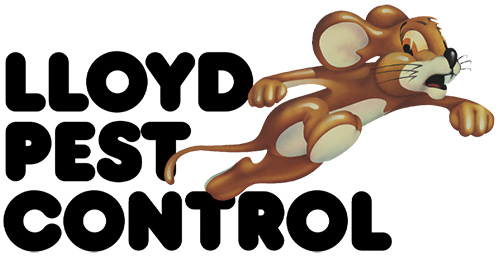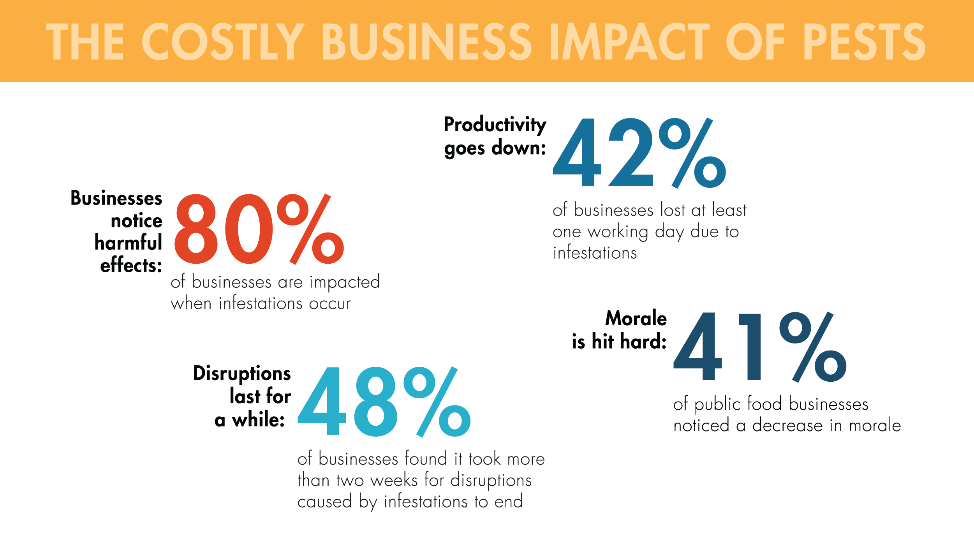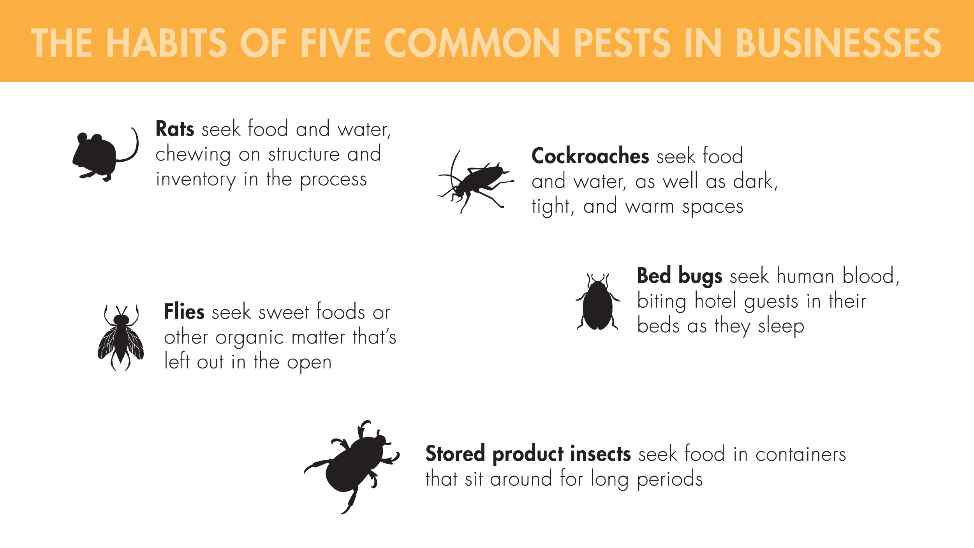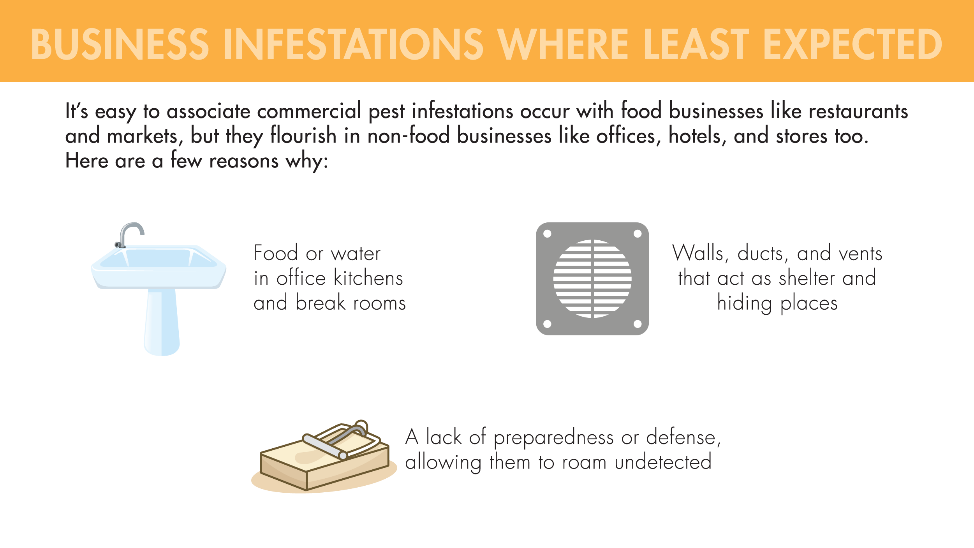Pests: A Big Burden on California Businesses
Pest Control and Extermination Tips
If you’re trying to run a successful business, you don’t want anything to get in your way. Selling a quality product or service, getting the word out, and maintaining a clean physical environment – they’re all important to your bottom line. But when pests show up, the bottom line is that their presence may be detrimental. Whether it’s nibbling rodents or pesky insects, pests are costly.
Pests hit every major industry in Southern California, including tourism, education, food service, and retail. No matter what kind of business you own, you don’t want critters getting in the way of your operations. We get that, and we’d like to help you stay on track without them.
Pests and Businesses: A Perfect (and Problematic) Match
Each year, pests cause nearly $10 billion in damage to businesses worldwide. This number is massive, and it doesn’t even include the loss of revenues that results from infestations – this amount hovers around $20 billion a year. Who would’ve ever thought such tiny creatures could wreak so much havoc? But as they infest buildings in large groups, their strength (and devastation) comes in numbers.
It makes sense, then, why the costs are so high in businesses. Almost every building-invading pest has what it takes to cause problems in such environments, as they:
- are small enough to get through ducts, cracks, and openings
- only need small amounts of food and water each day
- reproduce at extremely high rates
Rats, for instance, only need three weeks to give birth, often to as many as 16 pups. Smaller pests, like flies and moths, reproduce at an even faster rate. But as long as your business environment offers them what they need to survive, they’ll continue to be a problem – and a costly one at that. In addition to their potential for damage, think about their possible negative effects on employee morale and social media publicity.
The Pests Most Likely to Strike
1. Rats: Rats’ fast reproduction cycle wouldn’t be as big of a deal if it wasn’t for their chewing abilities. In fact, rats have a physiological need to chew. They come indoors to seek food and shelter, and they may end up costing your business a lot of money as they chew through walls, wiring, and inventory. To keep rats under control, cut off their entry points and food sources.
2. Cockroaches: Like rats, cockroaches are often found scurrying across floors, as they slip through openings in buildings and seek out food. Most of the time, though, they tend to inhabit dark, moist spaces where they’re difficult to detect. The popular German cockroach specifically loves warm spaces. To keep cockroaches under control, cut off their entry points and clean up food sources.
3. Flies: We typically associate buzzing flies with unsanitary conditions, as all species are attracted to decayed organic material. But the pesky fruit fly causes a lot of problems for businesses in California because it craves sweet substances. It’s a major threat for restaurants, who constantly have sugars, syrups, fruits, and vegetables sitting around. To keep flies under control, take care of spills, take out the trash, and maintain a clean workplace.
4. Bed bugs: Bed bugs are usually a problem in homes, but outbreaks in hotels are common as well. They’re prevalent in our beds, as they feed on human blood while we sleep. But they’re also hitchhikers, which is how they get from one guest’s suitcase to your hotel’s clean linens. To keep bed bugs under control, check for signs of them regularly (otherwise, you won’t notice them until they bite) and call in an experienced pest control company if you see any.
5. Stored product insects: A variety of insects are known specifically to infest containers of stored food, called “stored product insects.” Common types of this pest in the region include cigarette beetles, drug store beetles, and Indian meal moths. Ranging by the species, they seek out nuts, cereal, and more. Most infestations occur before food gets to a restaurant shelf, but they can occur if containers sit around for too long. To keep stored product insects under control, rotate through stored food consistently.
How Your Food Business May Be Affected
It’s obvious why businesses like restaurants, grocery stores, and food manufacturers are prone to pest invasions. The presence of food and water brings rats and cockroaches indoors, and it also attracts flies and stored product insects. Not only would the replacement costs for food be large, but so would the potential health risks if the problem isn’t noticed in time. A customer getting sick from your specialty dish would spell catastrophe for your restaurant.
How Your Non-Food Business May Be Affected
Businesses that don’t prepare or serve food are popular spots for pests as well. Southern California is a diverse economic sector; in the region, several industries thrive – yet, they’re also at risk of pest problems. The following types of non-food businesses are notable pest hangouts:
- Manufacturers
- Offices
- Hotels/motels
- Event venues
- Popular attractions
- Retail stores
- Schools
As you can see, virtually every industry is at risk. A big reason insects and rodents do so much damage in the aforementioned industries is because companies are often unprepared. In fact, only 28 percent of non-food businesses are worried about an infestation harming their reputation. This lack of concern allows pests to work undetected, or without effective treatment even after detection.
What many business owners forget is that even if you’re not making or serving food, you still probably have food or water around. Your employees may prepare or store meals, leaving break rooms and kitchens vulnerable. Also, all businesses feature a variety of areas (walls, ducts, vents, etc.) where pests can nest out of sight. Many species of flies seek out office drains and become hard to detect, and cockroaches and rats tend to hide in tight spaces.
Professional Pest Control Gives Businesses the Best
Pests are highly destructive to businesses of all kinds. Whether it’s in your restaurant’s kitchen, your office’s break room, or your hotel’s suites, infestations pop up wherever there’s food or shelter. But there’s only so much you can do on your own to combat them. With the help of professional pest control, you’ll get your business covered more extensively.
At Lloyd Pest Control, we offer commercial services to treat a variety of businesses in Southern California. With our help, you’ll receive not only top-notch extermination, but also education on how to stop pests from showing up in the first place. With our help, you’ll be able to focus on running your business, as you have better things to think about than the presence of pests. If you need pest services for your business, contact us today and get a free quote.









